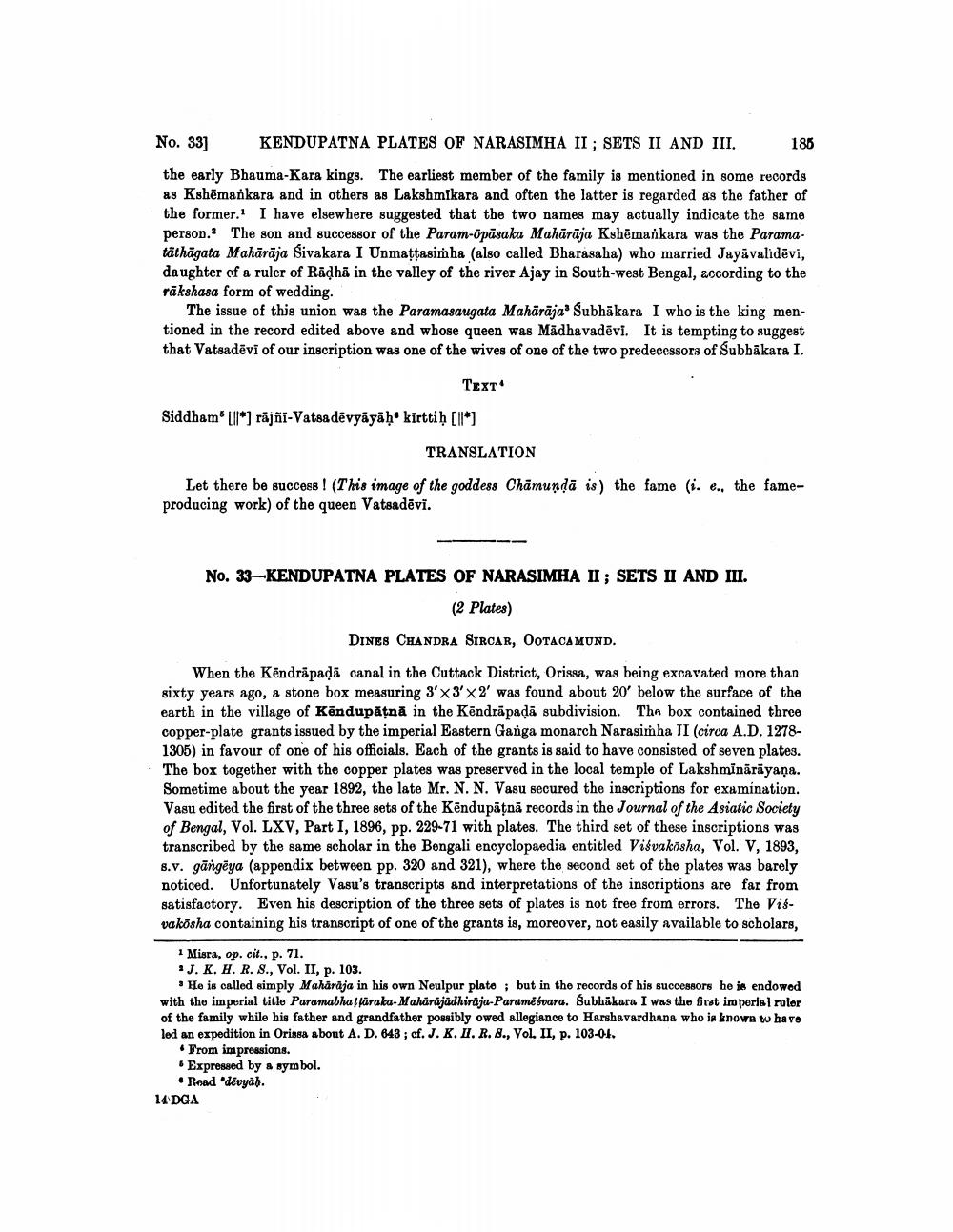________________
No. 33] KENDUPATNA PLATES OF NARASIMHA II ; SETS II AND III. 186 the early Bhauma-Kara kings. The earliest member of the family is mentioned in some records as Kshēmankara and in others as Lakshmikara and often the latter is regarded as the father of the former. I have elsewhere suggested that the two names may actually indicate the same person. The son and successor of the Param-õpāsaka Mahārāja Kshēmankara was the Paramatäthāgata Mahārāja Sivakara I Unmattasimha (also called Bharasaha) who married Jayāvalidēvi, daughter of a ruler of Radha in the valley of the river Ajay in South-west Bengal, according to the rākshasa form of wedding.
The issue of this union was the Paramasaugata Mahārāja. Subhākara I who is the king mentioned in the record edited above and whose queen was Mādhavadēvi. It is tempting to suggest that Vatsadēvi of our inscription was one of the wives of one of the two predecessors of Subbākara I.
TEXT
Siddham [!]*] rājñi-Vatsa dēvyāyāḥ kirtti) [11*
TRANSLATION
Let there be success! (This image of the goddess Chāmundā is) the fame (i. e., the fameproducing work) of the queen Vatsadēvi.
No. 33—KENDUPATNA PLATES OF NARASIMHA II; SETS II AND III.
(2 Plates) DINES CHANDRA SIRCAR, OOTACAMUND.
When the Kēndräpada canal in the Cuttack District, Orissa, was being excavated more than sixty years ago, a stone box measuring 3' X 3'X2' was found about 20' below the surface of the earth in the village of Kēndupățnā in the Kēndrāpadā subdivision. The box contained three copper-plate grants issued by the imperial Eastern Ganga monarch Narasimha TI (circa A.D. 12781305) in favour of one of his officials. Each of the grants is said to have consisted of seven plates. The box together with the copper plates was preserved in the local temple of Lakshminārāyana. Sometime about the year 1892, the late Mr. N. N. Vasu secured the inscriptions for examination. Vasu edited the first of the three sets of the Kēndupātnā records in the Journal of the Asiatic Society of Bengal, Vol. LXV, Part I, 1896, pp. 229-71 with plates. The third set of these inscriptions was transcribed by the same scholar in the Bengali encyclopaedia entitled Visvakõsha, Vol. V, 1893, 8.v. gāngēya (appendix between pp. 320 and 321), where the second set of the plates was barely noticed. Unfortunately Vasu's transcripts and interpretations of the inscriptions are far from satisfactory. Even his description of the three sets of plates is not free from errors. The Visvakosha containing his transcript of one of the grants is, moreover, not easily available to scholars,
1 Misra, op. cit., p. 71. :J. K. H. R. S., Vol. II, p. 103.
• He is called simply Mahārāja in his own Neulpur plate ; but in the records of his successors he is endowed with the imperial title Paramabhaffaraka- Maharājādhiraja-Paramédvara. Subhākara I was the first imperial ruler of the family while his father and grandfather possibly owed allegiance to Harshavardhana who is known t havo led an expedition in Orissa about A. D. 643 ; of. J. K. II. R. 8., VOL. II, p. 103-01.
. From impressions. • Expressed by a symbol.
• Road devyäb. 14 DGA




